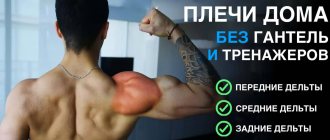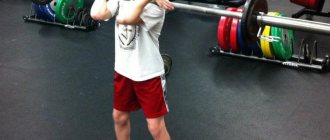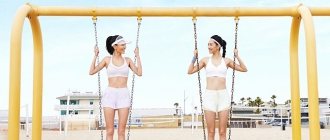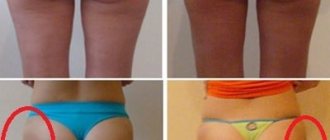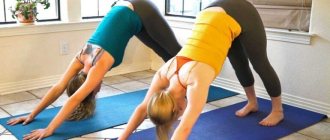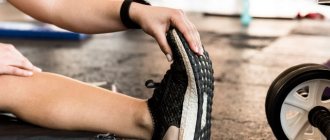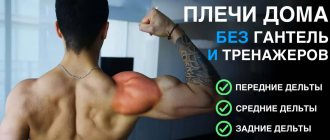Triceps exercises
Standing with a towel
- You take a towel, raise your arms above your head and bend your elbows to a 90-degree angle.
- Your partner stands behind you, grabs the towel and pulls it on.
- Overcoming your partner's resistance, you straighten your arms.
Perform three sets of 10 reps.
Push-ups with feet on shoulders
- The partner gets down on one knee.
- You stand behind him in a lying position and put your legs on his shoulders.
- You do push-ups in this position.
Perform three sets of 10 reps.
Bench press
- You lie on your back, stretch your arms up.
- The partner stands upright, lying down with support on your hands.
- You are doing a bench press.
Perform three sets of 10 reps.
Ab exercises
Full extension
- Your partner gets on all fours and lowers his head.
- You sit on your partner, facing his legs, place your legs behind his inner thighs, and raise your arms straight up.
- You lean your body back, trying to reach the floor with your hands, and then rise to the starting position.
Perform three sets of 20 reps.
Lateral body lifts
- You lie on the floor on your side, put your hands behind your head.
- Your partner holds your ankles on the floor.
- You lift and lower your body.
Perform three sets of 20 reps.
Double ab exercise
- You lie on your back, bend your knees, and place your feet on the floor.
- Your partner lies on his back with his head between your feet and wraps his hands around your ankles.
- You perform a regular abdominal press.
- Your partner performs a straight leg press.
- Do one set and switch places.
Perform three sets of 20 reps.
GENERAL DEVELOPMENTAL EXERCISES IN PAIRS
Purpose of exercises
Exercises in pairs help develop strength, strengthen joints and increase their mobility. In addition, in these exercises such motor actions are possible that cannot be done without the help or support of a partner, which significantly enriches the motor skills of students. Thus, resistance exercises develop in students the ability to show maximum effort or accurately calculate their intensity to provide resistance to a partner, which contributes to the development of muscle sensitivity. In this case, muscle work can occur in different modes: static and dynamic (overcoming and yielding in nature). Exercises where a partner provides assistance or support in performing certain movements contribute to the formation of the ability to coordinate one’s actions with the actions of a comrade (partner).
The role of partners in these exercises is different:
- both partners perform movements that are completely identical in form and nature (mirror or with the same parts of the body;
- the partner provides assistance, support or resistance to the main performer.
Exercises in pairs with various objects (gymnastic stick, medicine balls of different weights, jump rope, exercises on the gymnastic wall and bench) due to the specifics of the objects and equipment, place increased demands on the body of the practitioner. All these items allow you to diversify exercises, selectively influence the desired muscle group, develop the speed of muscle contractions, strictly dose the load, and develop the ability to regulate tension and relaxation of individual muscle groups.
The value of exercises in pairs is also undeniable for the development
a number of skills of practical importance. For this purpose, exercises are used in pulling and pushing, lifting and carrying a partner, elements of wrestling, throwing and catching a ball, passing objects and others that contribute to the special preparation of students for mastering more complex motor skills, as well as general physical development.
Rules for compiling a complex and recording exercises in pairs
When compiling a set of exercises in pairs, it is recommended to adhere to the same rules as in exercises without an object, namely:
- start with general impact exercises at a slow pace (such as stretching);
— increase the load gradually, alternating the work of different muscle groups;
- alternate exercises according to the nature of the effect (on strength, flexibility, relaxation, etc.);
- give the most intense exercises in the middle or second half of the complex;
— complete the complex with exercises of moderate intensity. Some exercises in pairs can be included as separate tasks in regular complexes or in series of 2-4 exercises to develop a certain motor quality. Some of the exercises with objects, primarily with a jump rope and a medicine ball, exercises of an applied nature, as well as exercises that require large muscular and volitional efforts, are best done in the main part of the lesson, when it is necessary to master the technique of complex coordination movements.
When describing the exercises, the starting position of each of them is first indicated, and then a description of the actions for both partners follows, if necessary.
If partners perform the same actions at the same time, then it should be written like this:
I. p. - standing facing each other at a distance of one step, hold hands. 1-2 - squat on the right, left forward, arms to the sides; 2 - i. P.; 3-4 - the same, on the other leg.
If the exercise needs to be performed in one direction, when the first numbers
Zach. 2479
should perform to the left, and the second to the right, then in this case it is better to say: “tilt towards the door or lunge towards the windows,” that is, indicate some landmark in the hall that determines the direction of movement.
In this group of exercises, commands are given to start and end them in accordance with the methodological method of creating an idea of the exercise.
Exercises in which partners perform different motor tasks are most often performed in an individual rhythm and tempo, and here it is necessary to indicate the actions of each partner. The partner performing the main actions is considered first, and his partner is considered second. In this case, the exercise should be written like this:
I. p. - first: gray haired, hands behind head; second: crouching down facing the first one, hands on the first one’s ankles. - ../ts First - falls on
' —■"!// back and returns to i. P.; the second one presses the partner’s ankles and feet to the floor. M. u. —medium pace, perform with force (without jerking), touch the floor with your shoulder blades.
Methodological instructions should reveal the most essential aspects of performing the exercise: form, tempo, nature of movement, sequence of actions and execution options.
In these exercises, the teacher gives a task how many times to perform it, for example: 25 bends, 10 push-ups, etc. To start and end the exercise, it is more advisable to give instructions.
Organization and methodology of conducting exercises in pairs
Exercises in pairs are always very emotional, they are usually accompanied by laughter and noise. Positive emotions are quite natural, but they should not cross certain boundaries, as they can cause noise, self-indulgence and disorganization of activities. Inattention to the teacher's explanation and violation of established rules of execution
exercises can lead to injury. Therefore, when conducting exercises in pairs, you should strictly adhere to the following rules:
1. There must be clear organization and reasonable discipline, based on strict compliance with all commands, orders and instructions of the teacher.
2. The principle of accessibility is strictly observed. Offer students an exercise that is difficult in terms of coordination and tension, for which they are already prepared. It is necessary to gradually lead students to master new tasks.
3. Select pairs in such a way that the height, weight and strength of the participants are approximately equal. Excessive differences in strength or height make exercise sometimes dangerous and in most cases uninteresting for both strong and weak partners. Boys should be paired with boys, and girls with girls. This is especially important to consider in those classes where the difference in strength between boys and girls is greater than at a younger age.
4. Conveniently and rationally place pairs so that they do not interfere with each other.
5. In exercises without objects, students must first be familiarized with the methods of hand grips that are necessary to perform exercises in pairs.
6. The exercises must be explained precisely, clearly and in sufficient detail. Immediately indicate in what initial positions the partners are (place, direction, etc.), and, if necessary, show it. You can call one or two students to demonstrate. Demonstration together makes it easier to create a correct understanding of the exercise.
When explaining a new exercise, it is necessary that all students have a clear view of those demonstrating the exercise. To do this, you can ask students to take two steps back from the middle (increase the distance between partners) or turn the class to face the teacher. Before commanding the start of the exercises, it is necessary to check the correctness of the starting positions taken, special attention should be paid to the correct grip, since the effect of the exercise itself depends on this, indicate the sequence of actions of the partners, tempo, rhythm.
It is better to learn exercises using the “show and tell” or “by division” method. These methodological techniques allow the teacher to promptly warn students against possible mistakes and point out the most significant points on which the correct execution of the exercises depends. Methodical
The “by divisions” method organizes and disciplines students more, since with it students consistently perform one action after another.
7. In resistance exercises, the teacher must warn and observe so that their implementation does not turn into a kind of “competition”. When performing these exercises, each person must resist as much as their partner can in order to allow the exercise to be completed. It is important to teach students to dose their efforts so that the sharpness of muscle sense and the ability to subtly differentiate muscle tension develop. Maximum effort can only be used in special exercises (“who will win”) and in exercises of a static nature.
During resistance exercises, students often have their correct breathing rhythm disturbed (holding their breath, straining). Therefore, the teacher is obliged to indicate at what moments you need to inhale and exhale, and remind you of this during the exercises.
8. When performing stretching exercises in pairs, the student whose muscles are being stretched must completely relax them and offer no resistance. This “passive” position places greater responsibility on the person helping to perform the stretch and requires greater responsibility from him for his actions. He must skillfully measure the amount of force applied so as not to cause injury to his partner. It is necessary to carefully ensure that each exercise begins with light, short and springy swings, not at full strength and not characterized by abrupt movements. Increase the amplitude gradually, ending each movement with a small jerk.
Before performing stretching exercises, it is recommended to perform warm-up exercises to avoid injury. When performing exercises with the help of a partner, you should not experience severe pain; slightly noticeable pain is possible.
9. When selecting exercises in pairs for younger schoolchildren and girls (especially poorly prepared ones), the teacher should avoid those that cause unbearable tension in the whole body. For example, you should not use exercises with climbing on your shoulders, squats with a partner on your shoulders, lifting a partner by the elbows, etc. Only in high school with boys can you use exercises such as lifting a partner lying on the floor by the head or jumping and squats with a partner on the shoulders, etc.
10. It is very important to monitor the nature and pace of performing exercises in pairs, since each of them has its own pace and rhythm.
Movements involving large muscle groups are performed at a slow pace. For small muscles the pace can be accelerated. As a general rule, keep in mind that exercises in pairs should be performed more slowly than regular exercises. To coordinate movements and maintain the desired tempo, it is advisable to carry out exercises with counting. Some exercises are performed at an individual pace and rhythm, such as resistance exercises. In this case, you need to suggest a recommended tempo.
11. In those exercises where partners perform movements that are different in form and nature (one performs bends, and the other holds him by the ankles), it is necessary to provide for an organized change of roles. If such exercises are performed at an arbitrary rhythm, then you need to indicate the number of executions and give the order “Finish!” after approximately 70% of the students completed the task. After this, on command, the pairs change places.
12. As a rule, a set of exercises in pairs is carried out in open formation in a column of two or four. Some simple or previously learned exercises can be done in motion. It is advisable to use both variants of the passing method, i.e., perform exercises by moving around the perimeter of the site in a column of two or through the center in a column of two or four. In this case, students return to their original places around the perimeter of the site.
PRACTICAL MATERIAL
| AND |
Exercises for strengthening the arm muscles of the shoulder girdle
Exercise 1
I. p. - standing facing each other at a distance of two steps, arms forward, palm to palm.
Bending their arms, both partners lean towards each other with their straight bodies and, pressing on the partner’s palms, slowly straighten their arms in and out. P.
Ex.2
I. p. - standing facing each other in a stance with your right (left) legs apart at a distance of one step, arms forward, fingers clasped.
Alternate flexion and extension of the arms with resistance.
Ex.3
'Ch I. p. - stand with legs apart at the back of the head, friend
to a friend, arms to the sides, the second one holds the hand of the first one.
The first one puts his hands down, the second one resists him. Then the first one raises his arms to the sides, and the second one holds him. The same thing, raising your hands up.
Ex. 4
I. p. - first: stand with legs apart, arms forward and downwards; second: standing facing the first at a distance of half a step, holds the first by the hands at the wrist joints.
The first one forcefully spreads and closes his hands, the second one resists him.
Ex. 5
I. p. - first: narrow stand with legs apart, arms forward and up; second: stand with legs apart facing your partner, holding his hands at the wrist joints.
The first one raises or lowers his hands, and the second one holds them.
Ex. 6
I. p. - first: in a standing position, legs apart, arms up; second: a narrow stance of the legs apart at the back of the head of the first, holding his hands at the wrist.
The second one tries to spread the first one’s arms to the sides; the first one resists him. And vice versa, the first one tends to spread his arms to the sides, and the second one resists him.
Ex. 7
I. p. - first: gray, arms to the sides; second: standing behind the partner, holding his hands at the wrist.
The second, resting his knee on the back of the first, tries to pull his arms back, the first offers resistance. The same thing, changing the direction of efforts.
Ex. 8
I. p. - first: sitting, hands forward; second: stand with your feet apart behind your partner, bend over and take his hands at the wrist.
The first one tries to spread his arms to the sides and back; the second holds back the efforts of the first. The same thing, changing the direction of efforts.
Ex. 9
I. p. - first: hands back; second: standing at the back of the head of the first at a distance of a step, takes his hands at the elbow.
The first one tries to lower his hands down; the second one restrains its movement.
Option: the second, using springy pressure at the elbow joints, brings the tense arms of the first together.
Ex. 10
I. p. - second: emphasis while kneeling; first: standing on the side of the partner’s head, takes a lying position, hands on the shoulders of the second.
The first one is to bend and straighten your arms while lying down. The same, but both partners bend and straighten their arms.
Ex.11
I. p. - second: lies on the back, legs apart, arms forward; first: lying down on the side of the partner’s legs, resting his hands on his hands.
The first one bends and straightens the arms.
Options: i. n. - the same: a) only the second bends and extends the arms; b) both partners bend and straighten their arms at the same time; c) bend and straighten your arms alternately.
Exercise 12
I. p. - first : lying on your back, arms forward; second: from the side of the partner’s legs, sits in his arms, legs apart (feet at the knees of the first), hands behind the head.
The first one bends and straightens the arms.
Exercise 13
I. p. - first: lies on the back, legs apart, arms forward; second: in a resting position, legs apart, resting his hands on the shins of the first, and his legs on the hands of the partner.
Partners simultaneously bend and extend their arms.
Exercise 14
I. p. - first: lying down; second: lying in support on the side of the partner’s head, hands on the shoulder blades of the first.
The first one bends and straightens the arms.
Option: a) both bend their arms at the same time; b) bend and straighten their arms alternately; c) bends and straightens the arms of the second.
Ex. 15
I. p. - second: lies on the back, arms forward; first: lying on the side of the partner’s head and leaning on his hands.
The first one bends and straightens the arms.
Exercise 16
I. p. - first: lying on your back, arms up, legs forward; second: from the side of the partner’s head, he stands on his palm and takes hold of the first person’s feet.
The first one is lifting the second one, arms forward, then bends and straightens the arms.
Exercise 17
I. p. - first: in support, lying legs apart; the second: stands between the legs of the first, facing him, holding his legs at the knees.
The first one bends and straightens the arms.
Option: the same, but the second one holds the first one at the ankles.
Exercise 18
I. p. - stand on the right knee facing each other, the arms of the same name are bent and clasped in a “lock”, the elbows are on the knees, the left hand is on the belt.
Partners press hard on each other's hand.
Ex. 19
I. p. - standing in a right lunge, facing each other, arms bent, palm to palm.
Each partner tries to straighten his arms forward and pull his partner’s arms back.
Mobility exercises
shoulder joint
and stretching the muscles of the shoulder girdle
Ex. 20
I. p. - stand with legs apart (legs together) facing each other at a distance of a long step, leaning forward, hands on the partner’s shoulders.
Simultaneously bend forward, bending over, pressing with straight arms on the partner’s shoulders.
Ex. 21
| ^S3*338^ |
I. p. - kneeling facing each other at a distance of a step, bending forward, hands on the partner’s shoulders. Trying to sit on your heels with simultaneous springy bends forward, press your hands on your partner’s shoulders.
G
Ex. 22
I. p. - first: sitting, arms up (behind the head, to the sides); the second: in a stand on one knee from the back, he rests his knee between the shoulder blades of the first and grabs his hands by the elbows. The second one presses with his knee in the area of the shoulder blades of the first one and with springy movements moves his arms back, gradually increasing the amplitude.
Ex.23
I. p. - standing tightly with your back to each other, hold hands below.
Both partners take a step forward, arms to the sides. Then do the same with the other leg. The same, but hands up through the sides; the same, with springy swings in the lunge.
Ex.24
I. p. - standing tightly with your back to each other, hands in a “lock” up and out.
Both partners perform a lunge with the right, arms to the sides, then a lunge with the left.
Ex.25
I. p. - standing close to each other, hold hands crossed from behind.
Bend forward and jerk your arms back. Each student presses his hands on his partner’s hands.
Ex. 26
HH-.-
I. p. - first: in a standing position, legs apart, leaning forward, hands back in the “lock”; second: stands at the side of the partner, one hand is on the head of the first, the other hand holds the clasped hands.
The second one holds the head with one hand, and with the other hand, with springy movements, pulls the hands of the first one back.
Ex. 27
I. p. - first: in a wide stance, legs apart, arms to the sides; second: standing behind, holds the first by the arms above the elbow.
The second one bends his leg, presses his knee between the partner’s shoulder blades and with springy movements moves the first one’s arms back, gradually increasing the amplitude.
Exercises to develop leg muscle strength
Ex. 28
I. p. - first: lies on his back, hands behind his head; the second: stands in a half-squat at the side of the first, taking the partner’s legs at the ankle. The first one tries to put his raised leg forward; the second one holds the partner’s legs. The same thing, but changing the direction of effort.
Exercise 29
I. p. - first: lies on the back, legs apart and raised; second: standing on the side of the partner’s legs, holds him by the ankles.
The first one tries to connect the legs; the second holds his legs; the same thing, but the second one tries to spread his legs, and the first one offers resistance.
Exercise 30
I. p. - first: in a stand on the shoulder blades; second: stands on the side of the partner’s legs and holds him by the legs at the ankles.
The second one tries to spread the legs of the first one to the sides (back and forth); the first one offers resistance. The same thing, but changing the direction of effort.
Exercise 31
I. p. - first: lies on the back; second: stands on the side of the partner’s legs and holds his leg.
A. The second one tries to bend the leg of the first one and press it to the body; the first one offers resistance.
b. The second one tries to straighten the leg of the first one; the first one offers resistance.
Ex.32
| GU |
I. p. - standing tightly facing each other, hold hands, hands down.
Slowly squatting, pull away from each other, arms forward. Then slowly stand up in and out. n. The same, but moving one step to the side.
Ex.33
I. p. - standing facing each other at a distance of a step, hold hands, arms forward.
Pulling away from each other, squat on the left, right forward on the heel. The same, on the other leg.
Exercise 34
I. p. - standing facing each other at a distance of a step. Left hand forward and join hands; right leg forward and with your left hand grab your partner’s leg at the ankle-foot.
Both partners squat on one leg and then on the other. The same when performing spring squats.
Exercise 35
I. p. - standing facing each other at a distance of half a step, hands on the shoulders of the partner.
Both squat on the left, right to the side.
Option: i. p. - the same. 1 - squat, right to the side on the toe; 2—right to the side; 3-4 - and. P.; 5-8 - the same, on the other leg.
Exercise 36
I. p. - standing with your back to each other, hands clasped under the elbow.
Both squat on the left, the right one forward, then the same on the right.
Exercise 37
I. p. - wide stance with legs apart facing each other, arms forward and hold hands.
a) bend your right into a lunge; the same, left; b) squat on the left, then on the right.
Ex.38
I. p. - sitting with his legs bent tightly with his back to each other, his hands clasped under the elbow.
Pressing on each other's shoulder blades, slowly stand up, then slowly sit down. Do not move your feet.
Exercise 39
I. p. - first: in a squat on the left, hands on the belt; second: holds the partner’s sock.
The first one stands up and squats on one leg, and then on the other; the second one holds him by the sock.
Ex. 40
I. p. - second: sits astride the shoulders of the partner, bending his legs back and resting his toes on his back, hands on the shoulders of the first; first: in a standing position, tightly pressing the shins of the second to himself.
The first one lunges with the right and returns to i. P.; the same, on the other leg. The same, but lunge to the side.
Ex. 41
I. p. - second: sits astride the shoulders of the first, bending his legs back; first: in a narrow stance, legs apart (legs together), pressing the partner’s shins towards you.
The first one crouches and stands up.
Ex. 42
I. p. - first: lies on the back, legs bent forward; second: lies on his back on the side of the partner’s legs on his feet with his shoulder blades, arms up and takes the hands of the first.
The first bends and straightens his legs, raising and lowering the second, who, straining, straightens his torso.
Exercise 43
I. p. - first: lies on the back, legs forward; second: lies on his back on the side of the legs of the first, resting his shoulder blades on his feet, hands on his belt.
The first one bends and straightens the legs, lifting and lowering the partner, who maintains a straight body position, trying not to lift the legs off the floor.
Ex. 44
I. p. - first: lies on his back, bending his right hand forward, arms along the body, palms on the floor; second: from the side of the partner’s legs, he lies with his chest on his right foot and holds his shin with his hands.
The first one bends and straightens the leg, raising and lowering the second one. The same, with the other leg.
Ex. 45
I. p. - first: lies on the back, legs forward, hands on the floor along the body; second: from the side of the partner’s legs, it rests with the shoulder blades on his feet, arms forward.
The first one lowers straight legs forward and upward and returns to i. P.; the second - maintaining a straight body position, trying not to lift your socks off the floor.
Ex. 46
I. p. - first: lies on his back, legs bent forward, arms forward; the second: lies with his hips on the feet of the first, facing him, joining his hands with a face grip.
The first one straightens and bends the legs, raising and lowering the second one, which maintains a straight body position.
Ex.47
I. p. - standing with your back to each other, join your hands under the elbow, sit down.
Jumping in a squat, moving first to one side, then to the other.
Options: a) squat, placing one or the other leg forward on the heel; b) squat jumps with a 360° turn for 4 counts in one direction, for the next 4 counts in the other; c) jumps with a turn in a circle for 2 counts in one direction, for 3-4 - and. P.; then the same, in the other direction.
Ex.48
I. p. - standing facing in different directions, arms to the sides, hold hands with the right.
Jump in a circle on one half-bent leg, the other bent forward higher.
The same on the other leg. The same, bending the other back; jumping in a circle on one leg or the other.
Ex.49
I. p. - squat on the left, facing each other, the right forward on the heel, arms forward and hold hands.
Jumping in a squat with changing the position of the legs.
Exercise 50
I. p. - first: sits with straight legs; second: stand with legs apart facing the first at the partner’s knees.
The first one spreads his legs apart, the second one jumps over them into the main stance between the legs of the first one. Then the first one connects his legs, and the second one jumps over them into a stance with legs apart.
Ex.51
I. p. - stand sideways to each other at a distance of a step, facing in opposite directions, one hand on your partner’s shoulder, and the other on your own belt.
Three jumps on two, moving in a circle, and a jump with a turn in a circle, changing the position of the hands.
Ex.52
I. p. - squat facing each other, arms forward and hold hands.
Two jumps in one direction; two in i. P.; the same, in the other direction. The same, 4 jumps each; to 8.
Ex.53
I. p. - standing facing each other at a distance of a large step, arms forward and hold hands. )
Side step to the side and jump into
squatting, straightening up, side step in and. n. Then the same, in the other direction.
Ex. 54
I. p. - standing sideways to each other, facing in different directions, take your elbow with your right hand.
Jump on two in a circle in one direction, and then turn around and grab your elbow with your left hand.
)
Ex. 55
I. p. - standing with your back to each other, take your elbow. Two jumps in one direction; two in i. P.; the same, in the other direction.
Option: a) one jump each with a return to i. forward, backward, left, right.
Ex. 56
I. p. - standing facing each other at a distance of a step, arms forward and to the sides and hold hands.
2 additional steps in one direction, return to i. P.; the same, in the other direction. The same, but 4 additional steps in one direction and then in the other direction.
Ex. 57
I. p. - standing with your back to each other, hold hands below, stand with your legs apart.
1 - jump legs together, arms to the sides; 2 - i. P.
Variation: two jumps with your back to each other, then turn around and two jumps facing each other.
Ex.58
I. p. - squat facing each other, hands on the shoulders of the i partner. |
Squat jumps in different directions.
Ex. 59
I. p. - second: stand with legs apart, half squat, hands on knees; first: 2-3 steps behind the second.
The first one takes two running steps and jumps his legs apart over the second one. Then he turns around and accepts and. p. of the second, and the second jumps over the first.
Option: jumps are performed through several students.
Ex.60
I. p. - standing facing each other on one leg, grab your partner’s hand with your right hand, and his raised leg with your left hand.
Jump in a circle on one leg and then on the other.
Option: i. p. - the same. Jumping on one leg to one side and then to the other.
Leg stretching and hip mobility exercises
Ex. 61
I. p. - first: in a stand on one leg, the other to the side, placing the toe on the partner’s knee; second: in a kneeling position, holding the first by the shin.
The first one performs bends alternately to the right and then to the left leg. The same, on the other leg.
Ex. 62
I. p. - second: knee stand; first: stand on one leg facing your partner, free leg on the other’s knee.
The first one performs springy tilts; the second helps him by pressing on his shoulder blades.
Ex. 63
I. p. - first: sit legs apart wider; second: stands behind the partner.
The first one performs bends, hands to toes; the second helps him with springy pressure on the shoulder blades, gradually increasing the amplitude. The first one tries to touch the floor with his chest.
Exercise 64
I. p. - first: sit legs apart wider, bending the right one back; second: stands behind the partner.
The first one bends to the left, trying to touch the knee with the chest; the second helps him with springy pressure on the shoulder blades, gradually increasing the range of movements.
Ex.65
I. p. - standing with their backs to each other, grip under the elbow, the other’s legs are bent.
The second one, straightening his legs, bends the first one towards his feet with springy swaying movements.
Ex.66
I. p. - sit your legs apart wider, facing each other, put your feet together, arms forward and hold hands.
The second leans back with a straight body, helping the first to bend forward deeper. Option: in and. The second one rests his feet on his partner’s knees, helping him spread his legs wider.
Ex.67
I. p. - stand on your knees facing each other at a distance of a large step, bend forward and hold hands. The first one slowly leans back with his straight body, and the second one bends over and lies on his stomach. Just as slowly they return to i. n. The same, in the other direction.
Ex. 68
I. p. - first: sitting legs apart wider, bending the right one back, hands behind the head; second: standing behind the partner in a legs apart position, holds the first by the hands above the elbow.
The first one performs springy tilts to the right; the second - by pressing on the right shoulder and left elbow, helps the first to bend deeper.
Exercise 69
I. p. - first: lies on the stomach, right back, leaning on the forearms; second: on the side of the partner in gray hair on his heels.
The second - leaning with one hand on the partner’s back, with the other hand, with springy movements, moves the right leg back. Then do the same on the other leg.
Ex. 70
I. p. - first: lies on the back, right hand forward, arms along the body; second: in a kneeling position on the partner’s side.
The second, with springy movements, helps the first to raise his leg higher.
Ex. 71
I. p. - first: stand on one leg, the other forward, hands behind the head; the second: stands on the side facing the partner, puts one hand on his shoulder (or on his back), and with the other takes the first’s raised leg from below by the shin.
The second one lifts the straight leg of the first one up with soft springy movements. The same, but fixing the final position of the leg. The same, on the other leg.
Ex. 72
I. p. - first: stand on one leg, the other to the side, hands behind the head; second: in a stance with legs apart from behind, facing the partner at the raised leg, grabs the shin from below with one hand (closer to the ankle).
The second, with his free hand, presses on the partner’s side and, with springy movements, helps the first to raise his leg higher to the side. Same thing on the other
